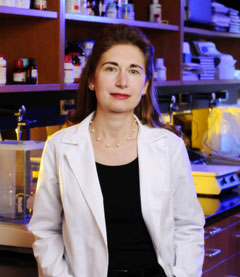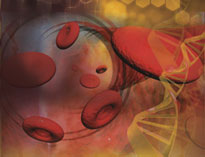Shalev Leads Diabetes Center
By Tara Hulen
 Anath Shalev hopes to lessen the impact of diabetes through research, training, clinical care, and outreach.UAB’s approach to diabetes research and treatment drew renowned scientist Anath Shalev, M.D., to become director of the Comprehensive Diabetes Center. However, she is equally excited about what can be done outside the lab to combat—and prevent—the disease.
Anath Shalev hopes to lessen the impact of diabetes through research, training, clinical care, and outreach.UAB’s approach to diabetes research and treatment drew renowned scientist Anath Shalev, M.D., to become director of the Comprehensive Diabetes Center. However, she is equally excited about what can be done outside the lab to combat—and prevent—the disease.
“More than 30 percent of people in Alabama are obese, and another 30 percent are overweight,” Shalev says. Because obesity is a leading cause of type 2 diabetes, UAB programs taken directly to people across the state could make meaningful and immediate differences in many lives, she explains.
Expansive View
Outreach is one aspect of Shalev’s expansive view of diabetes research and care. “It’s a complex disease that requires an interdisciplinary approach,” she says. Shalev comes to UAB from the University of Wisconsin-Madison, where she directed endocrinology, diabetes, and metabolism research and conducted groundbreaking studies on cellular processes that lead to pancreatic beta cell death associated with diabetes. Now she heads a center with more than 150 faculty members dedicated to combining diabetes research, training, and clinical care—the result of collaborative efforts involving UAB, Children’s Hospital, and the Birmingham community. Shalev also has been appointed to the Nancy R. and Eugene C. Gwaltney Family Endowed Chair in Juvenile Diabetes Research.
|
The Truth About Diabetes Persistent myths and common misperceptions lead people to make bad—and sometimes dangerous—decisions in dealing with diabetes. Read more |
The Comprehensive Diabetes Center is only a few years old, Shalev says, so there is a lot of work to dive into immediately. In addition to focusing on innovative collaborative research, recruiting more scientific talent for the center, and expanding educational programs for the public and professionals, Shalev wants to expand existing therapeutic options for patients. She also wants to leverage opportunities available through the UAB Center for Clinical and Translational Science and the wealth of research data produced by the UAB Division of Preventive Medicine.
“Diabetes complications will be another major focus,” Shalev notes. “They’re a big problem for the community, they take a huge toll in terms of people suffering, and treating them builds on some of UAB’s strengths.” As an example, she points to the UAB Multidisciplinary Comprehensive Diabetes Clinic, the only clinic in the state offering patients one-stop care from experts including ophthalmologists, neurologists, and kidney specialists.
Story continues below the video
Targeting TXNIP
“In terms of research, beta cell biology will be one major aspect because it’s so critical for both type 1 and type 2 diabetes,” says Shalev, who earned her medical degree from the University of Basel, Switzerland, and completed research fellowships at Harvard and the National Institute of Diabetes and Digestive and Kidney Diseases. The connection between beta cell death and diabetes “has been well established, but, no one knows the exact factors that are involved,” she explains.
However, in performing the first human pancreatic islet microarray study, Shalev identified thioredoxin-interacting protein (TXNIP) as a factor playing an important role in diabetic beta cell death. At Wisconsin, she further discovered that suppressing TXNIP protected pancreatic beta cells, in turn preventing the development of both types of diabetes. “We’re convinced this is a great target,” she says.
Lowering TXNIP even prevented diabetes in severely obese lab mice, which is exciting because “it means that the reduction of TXNIP could unlink obesity from diabetes,” Shalev says.
Shalev and her UAB colleagues are also keenly interested in studying the role TXNIP might play in other systemic effects of diabetes. For example, her team found significantly elevated TXNIP levels in the hearts of mice and humans with diabetes, which means that the protein may play a role in diabetic cardiomyopathy. She hopes that the research will one day lead to new drugs that could protect and promote a patient’s own beta cells while preventing or treating diabetes complications.
This story originally appeared in UAB Medicine, the magazine of the UAB School of Medicine
